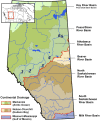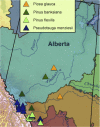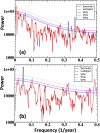Long-term reliability of the Athabasca River (Alberta, Canada) as the water source for oil sands mining
- PMID: 26392554
- PMCID: PMC4611663
- DOI: 10.1073/pnas.1509726112
Long-term reliability of the Athabasca River (Alberta, Canada) as the water source for oil sands mining
Abstract
Exploitation of the Alberta oil sands, the world's third-largest crude oil reserve, requires fresh water from the Athabasca River, an allocation of 4.4% of the mean annual flow. This allocation takes into account seasonal fluctuations but not long-term climatic variability and change. This paper examines the decadal-scale variability in river discharge in the Athabasca River Basin (ARB) with (i) a generalized least-squares (GLS) regression analysis of the trend and variability in gauged flow and (ii) a 900-y tree-ring reconstruction of the water-year flow of the Athabasca River at Athabasca, Alberta. The GLS analysis removes confounding transient trends related to the Pacific Decadal Oscillation (PDO) and Pacific North American mode (PNA). It shows long-term declining flows throughout the ARB. The tree-ring record reveals a larger range of flows and severity of hydrologic deficits than those captured by the instrumental records that are the basis for surface water allocation. It includes periods of sustained low flow of multiple decades in duration, suggesting the influence of the PDO and PNA teleconnections. These results together demonstrate that low-frequency variability must be considered in ARB water allocation, which has not been the case. We show that the current and projected surface water allocations from the Athabasca River for the exploitation of the Alberta oil sands are based on an untenable assumption of the representativeness of the short instrumental record.
Keywords: Alberta; climate variability; oil sands; paleohydrology; statistical hydrology.
Conflict of interest statement
The authors declare no conflict of interest.
Figures










References
-
- AESRD (Alberta Environment and Sustainable Resource Development) 2014 Athabasca River Basin. Available at esrd.alberta.ca/focus/state-of-the-environment/water/surface-water/press.... Accessed January 14, 2015.
-
- Canadian Association of Petroleum Producers 2013 The Facts on Oil Sands – Environment: Water. Available at appstore.capp.ca/oilsands/page/water-user-2012-01-23-03-01-29. Accessed January 14, 2015.
-
- Grant J, Huot M, Lemphers N, Dyer S, Dow M. Beneath the Surface: A Review of Key Facts in the Oilsands Debate. Pembina Institute; Drayton Valley, AB, Canada: 2013. Available at https://www.pembina.org/reports/beneath-the-surface-oilsands-facts-20130.... Accessed May 14, 2015.
-
- Government of Alberta 2015 Lower Athabasca Region: Surface Water Quantity Management Framework for the Lower Athabasca River. Available at esrd.alberta.ca/focus/cumulative-effects/cumulative-effects-management/m.... Accessed May 14, 2015.
Publication types
LinkOut - more resources
Full Text Sources
Other Literature Sources
Miscellaneous

